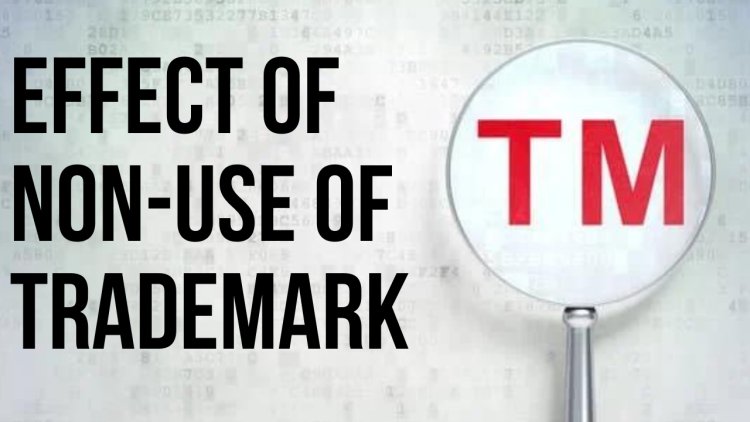The Effect of Non-Use of Trademark
This document explores the critical implications of non-use of trademarks, focusing on the potential consequences, legal proceedings, and the importance of maintaining active use to safeguard exclusive rights. The analysis encompasses the functions and rights associated with trademarks, with a particular emphasis on the Indian trademark system.

INTRODUCTION
A trademark is a symbol that provides protection to its owner by securing their exclusive right to use it or by granting another party permission to use it in exchange for money. Trademarks can be renewed in perpetuity by paying additional fees after the first term has expired. Trademarks encourage entrepreneurship by providing owners with recognition and financial benefits. They also prevent counterfeiters and other unscrupulous rivals from using similar marks to market inferior goods or services. The system promotes global trade by enabling anyone with initiative and skill to manufacture and sell goods and services under ethical standards. Trademarks are primarily used to identify the source or origin of products or services, which is why they are also known as flags of origin. A registered trademark confers exclusive rights to its owner.
The functions of a Trade Mark
The primary function of a trademark is to differentiate the goods or services provided by one organization from those provided by others. It plays a vital role in recognizing and distinguishing the origin of the product, while also serving communication, advertising, and investment functions. The trademark's scope is determined by the categories that assign one or more goods and services. Under the specificity principle, a senior trademark is protected against identical marks for the same goods, and as markets continue to expand and trade and business grow, an increasing number of trademarks are registered worldwide. Trademarks are typically words, names, symbols, devices, designs, or other distinctive signs or marks that identify the source of goods or services and differentiate them from those sold by others.
Rights of a Trade Mark user:
Trademarks are symbols that represent the source of goods or services. They allow consumers to identify products that come from a single entity or those approved by that single entity. By doing so, trademarks help build goodwill and protect the company's investment in that goodwill. Additionally, trademarks act as an important advertising tool for their owners and aid consumers by representing consistent quality. Trademarks are exclusive rights conferred on the owner.
If a trademark owner fails to use the mark with a definite intent to use it in relation to the goods, they may be considered as having abandoned it. However, if the owner's efforts to use the mark were hindered by a statutory ban on imports, and they can prove this, then they cannot be considered as having abandoned the mark under Section 46(3). In this case, the affidavit of Buttress negates such a situation, and thus, the issue under Section 46(3) being answered in favour of the appellant does not arise.
Non-use of the trademark
A registered trademark can be cancelled within five years of the date of completion. The registration process for a trademark in India can be challenging for proprietors who have not used their mark or granted consent for its use. In such cases, there must be valid reasons for the non-use of the mark, or else it may not be eligible for registration. Unlike some other countries, the Indian trademark system does not require the filing of an affidavit for uninterrupted use of the trademark. However, if a proprietor fails to use their trademark for a period of five years or more, the mark may be removed from the register of trademarks. It is important to note that once a mark is registered in India, the registration itself serves as sufficient evidence of its validity and ownership.
Effect of non-use of Trademark
When a trademark is not used for a certain period of time in India, it may be removed from the trademark registry. In some cases, new goods or services are introduced in the market using trademarks that have not been re-registered or have been unused for a long time. Trademark proprietors may choose not to object to the new trademark that infringes their existing mark due to the fear of the new user attacking the trademark on the grounds of non-use. This can lead to the trademark being completely removed from the registry. Rectification on the ground of non-use usually arises during opposition proceedings or infringement actions as a counterblast in India. If the proprietor of the trademark has not used the mark for more than five years and has not taken any steps to use it, they may tend not to object to the registration of similar marks by others or launch infringement proceedings.
Rectification Proceeding
In the realm of trademark registration, a "person aggrieved" has the right to request the cancellation or withdrawal of a registered trademark based on non-use. However, if the trademark has been listed on the Register for more than five years, the defendant in opposition proceedings may demand proof of actual usage. Requests for any corrections to the register of trademarks or for the removal of any registered brand from the register should be forwarded to the concerned zonal registrar of trademarks or the Intellectual Property Appellate Board (IPAB).
Once opposition proceedings have been initiated, it is crucial to determine whether the trademark owner has used the mark for the required period of time, based on the facts and circumstances. Failure to do so may result in the trademark owner losing any remedy available. However, if no application for rectification is made by a dissatisfied party and the registered proprietor begins using the trademark legitimately after the required five-year period, there is no obstacle to registering the trademark even if it has not been used legitimately for the required amount of time.
CONCLUSION
Trademark owners must use their marks to maintain their exclusive rights and prevent the risk of abandonment. Failure to use a trademark may lead to its removal from the registry. Non-use can also make trademark owners vulnerable to infringement by others. Interested parties can challenge the validity of a registered trademark based on non-use through rectification proceedings. It is crucial for both trademark owners and potential challengers to understand the nuances of these proceedings, as failure to engage in them in a timely and effective manner may result in the loss of valuable trademark rights.












